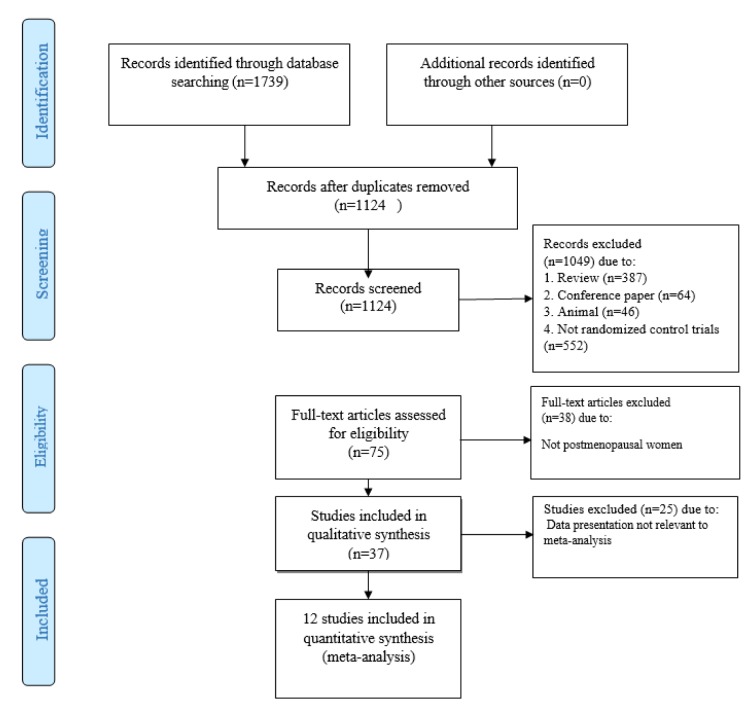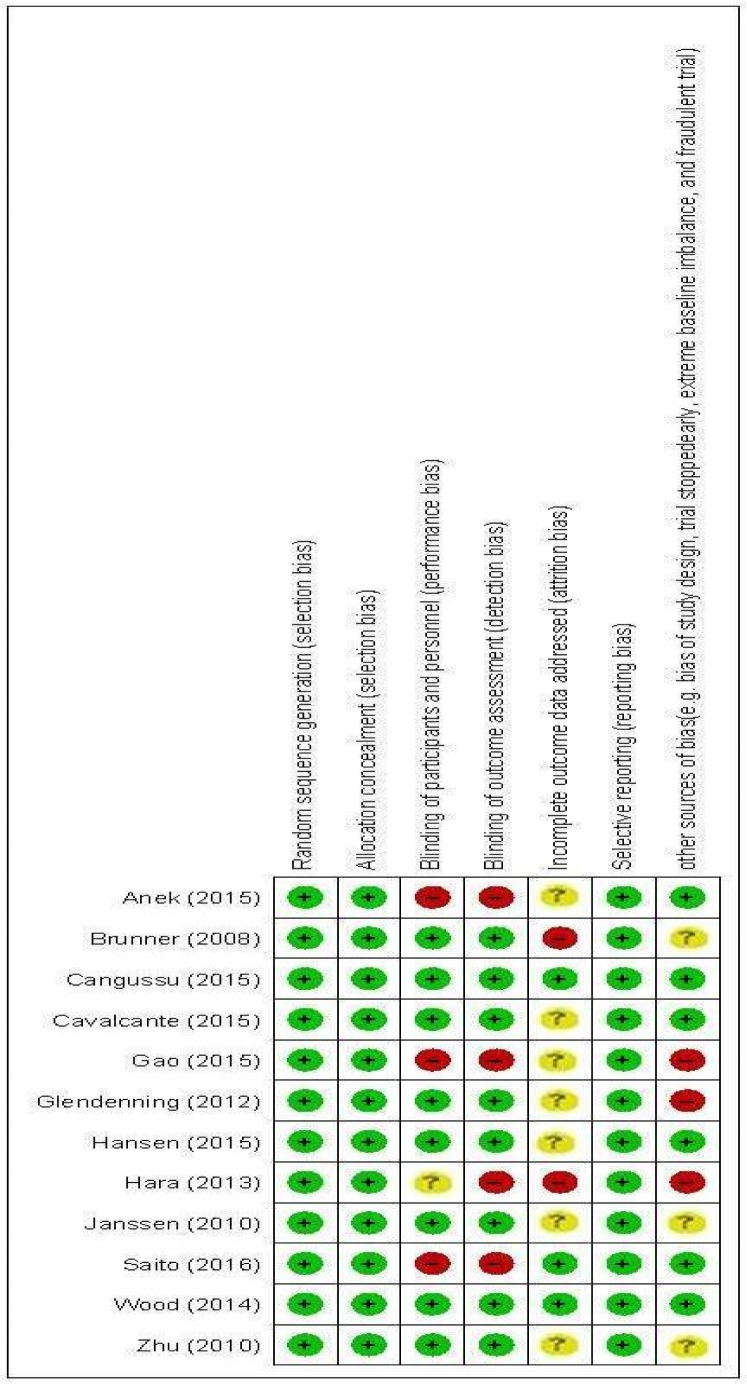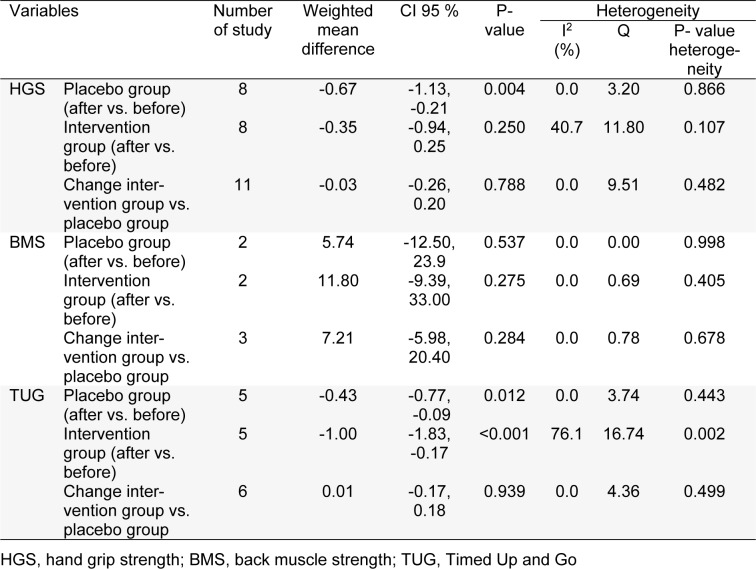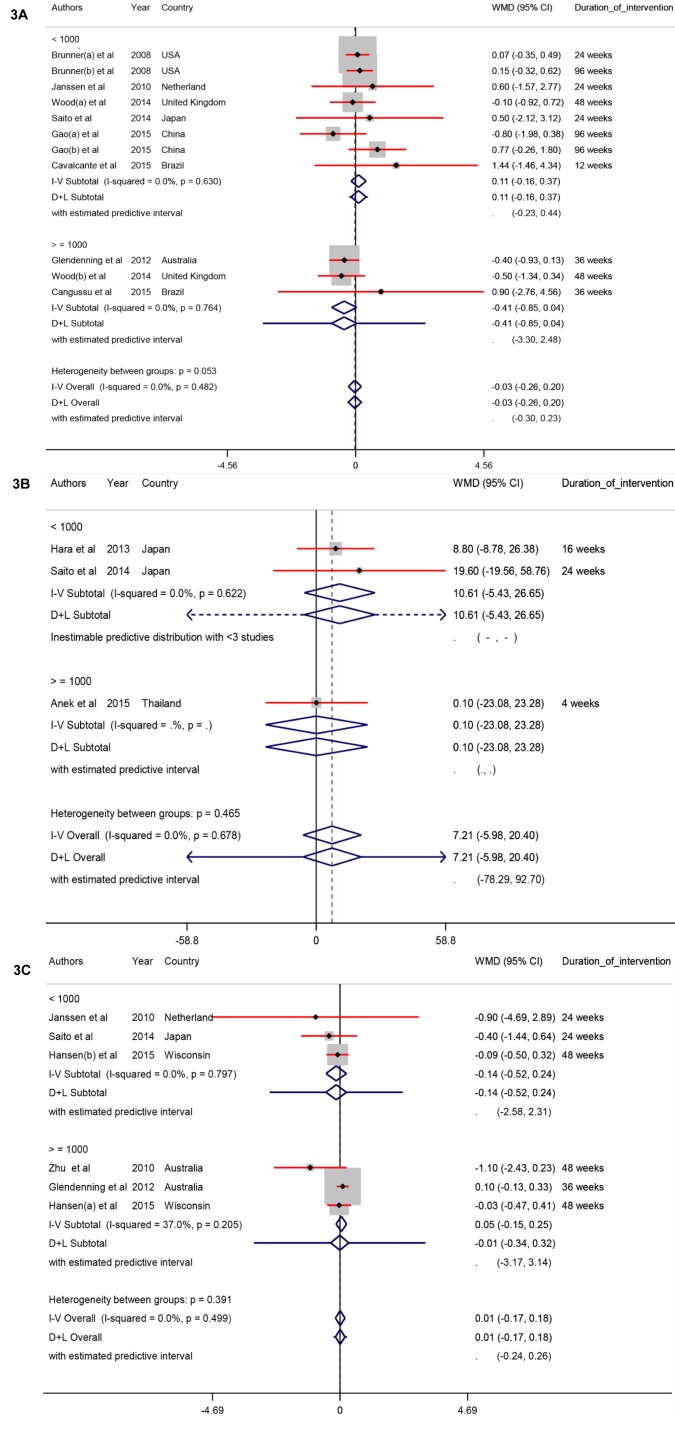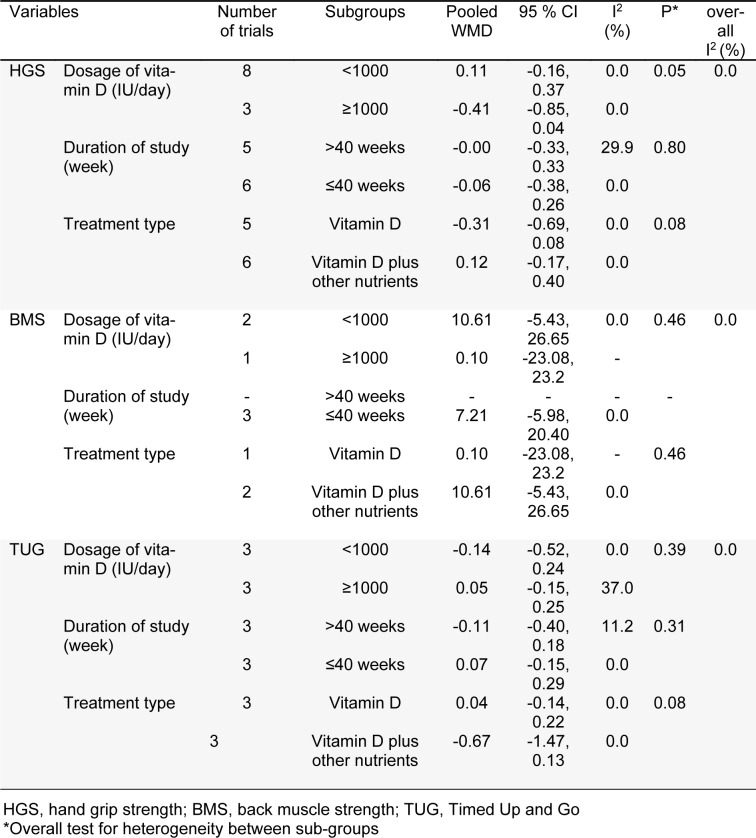Abstract
The loss of muscle mass and its strength is one of the most critical changes in aging which is associated with an increased risk of falls, osteoporotic fractures and mobility disability. Vitamin D, with its extra-skeletal benefits, might improve muscle function in elderly. The current systematic review and meta-analysis of randomized controlled trials (RCTs) was conducted to summarize available relevant data and determine the effect of vitamin D supplementation on muscle function among postmenopausal women. We reached databases including; Cochrane library, Embase, PubMed, and Web of Science database until the end of May 2018 to identify relevant published RCTs. Heterogeneity among included studies was assessed using Q-test and I2 statistics. Random-effect model was applied to pool data and weighted mean difference (WMD) was calculated representing summary effect size. Outcomes of interest included the effects of vitamin D supplementation on hand grip strength (HGS), back muscle strength (BMS), and Timed Up and Go (TUG). Twelve RCTs out of 1739 potential reports were included in our meta-analysis. The pooled findings showed that vitamin D supplementation had no significant effect on HGS (WMD -0.03 kilogram (Kg); 95 % CI, -0.26, 0.20; P=0.78), BMS (WMD 7.21 newton (N); 95 % CI, -5.98, 20.40; P=0.28), and TUG (WMD 0.01 second (S); 95 % CI, -0.17, 0.18; P=0.93) in postmenopausal women. Overall, the current meta-analysis showed that taking vitamin D supplementation by postmenopausal women did not affect markers of muscle function. Further studies are required to confirm the effect of vitamin D supplementation on markers of muscle function.
Keywords: vitamin D supplementation, muscle function, postmenopausal women, meta-analysis
Introduction
Muscle function is one of the main determinants of functional capacity among postmenopausal women. Lack of muscle mass and muscle strength occurs as important organic changes by aging and is remarkably associated with an elevated risk of falls and subsequent osteoporotic fractures, besides this severely influences the potential of movement (Orsatti et al., 2011[26]; Muir and Montero-Odasso, 2011[25]). Vitamin D deficiency is common among older populations worldwide, as more than 60 % of postmenopausal women are vitamin D deficient, regardless of other nutrient deficiencies (Rizzoli et al, 2006[30]; Holick, 2007[20]; Han et al., 2018[17]). In observational studies, optimal serum 25(OH)D levels have been significantly associated with improved musculoskeletal function and muscle strength (Bischoff-Ferrari et al., 2004[6]; Visser et al., 2003[36]). Further, postmenopausal women who were vitamin D deficient presented worse upper and lower limb muscle strength and physical performance compared to vitamin D sufficient control group (Iolascon et al., 2015[21]). Skeletal muscle cells have vitamin D receptor and adequate protein synthesis in these cells, which might be directed through vitamin D function (Holick, 2007[20]).
Current evidence evaluating the effects of vitamin D supplementation on musculoskeletal health has demonstrated promising results. In a meta-analysis conducted by Rosendahl-Riise et al. (2017[31]), vitamin D supplementation alone or its co-administration with calcium supplements significantly improved muscle strength among community-dwelling older individuals. In another meta-analysis, consuming vitamin D by healthy people significantly increased upper and lower limb strength (Tomlinson et al., 2015[34]). Moreover, Rejnmark (2011[29]) reported the advantages of vitamin D supplementation on muscle strength and function in older adults. In another trial, taking vitamin D by postmenopausal women increased their muscle strength, controlled lean mass loss and protected them against the occurrence of sarcopenia (loss of skeletal muscle mass) (Cangussu et al., 2015[10]). One-year treatment with high-dose vitamin D did not show any significant effect on muscular strength, balance or quality of life in postmenopausal osteoporotic women (Grimnes et al., 2017[16]).
Despite existing published RCTs evaluating the effect of vitamin D on muscle function, current evidence is inconclusive because of lack of trials conducted among younger populations and discrepant findings in older individuals. Discrepancies in current findings might be due to the differences in study design, study populations' characteristics, the dosage of vitamin D supplementation, the duration of intervention, co-supplementation with other nutrients and chronic comorbid conditions among elderly. This meta-analysis was conducted to summarize available data and to determine the effect of vitamin D supplementation on muscle function among postmenopausal women.
Methods
Search strategy and study selection
Two independent authors systematically searched databases including PubMed, EMBASE, Scopus, Cochrane Library, and Web of Science databases to identify RCTs investigating the impact of vitamin D on muscle function outcomes. Included trials were restricted to human clinical trials published in English until May 2018. The following MeSH and text terms were used to determine related studies, using their title and abstract: participants ["post menopause" OR "postmenopausal" OR "PMP"], intervention ("ergocalciferol" OR "alphacalcidol" OR "cholecalciferol" OR "eldecalcitol" OR "alfacalcidol" OR "vitamin D" OR "vitamin D2" OR "vitamin D3" AND "intake" OR "supplementation"), and outcomes ["hand grip strength (HGS)" OR "back muscle strength (BMS)" OR "Timed Up and Go (TUG)"].
To increase the possibility of including more related studies, the reference list of selected studies and previously published relevant reviews were manually searched.
Inclusion and exclusion criteria
First, duplicate studies and those clearly were not relevant were removed from further investigation. Then, the full-texts of remaining studies were retrieved to assess whether these trials met the inclusion criteria for the current meta-analysis. The inclusion criteria were as followed: being a human RCTs (either parallel or cross-over method), study population were post-menopause women, being a placebo-controlled trial, mean difference and standard deviations (SDs), standard error of the mean (SEMs), or 95 % confidence intervals (CIs) were available for considered outcomes including HGS, BMS, and TUG at both baseline and end of the intervention for each group. Observational studies, case reports, animal, and in vitro studies, and RCTs did not meet the minimum requirement for the assessment of methodological quality were excluded from this meta-analysis.
Data extraction and quality assessment
The quality of selected RCTs methodology was assessed, using Cochrane Collaboration risk of bias tool and the data were extracted, using standardized excel sheet, by two independent authors (JH and MA). The following items were used to assess the quality of selected clinical RCTs and the probable risk of bias: "randomization generation, allocation concealment, blinding of participants and outcome assessment, incomplete outcome data, and selective outcome reporting, and other sources of bias". The following data were extracted from each study: first author's name, publication year, participants' age, study design and location, sample size in treatment and placebo groups, dosage of intervention, type of vitamin D supplement and placebo, and the mean (SD) changes for muscle outcomes in each group. If muscle outcomes were measured at multiple durations of intervention or using different dosages of vitamin D supplementation in selected studies, those measurements were considered as separate trials in meta-analysis. Any discrepancy in data extraction was resolved with consensus or by discussing with a third author (ZA).
Data synthesis and statistical analysis
Weighted mean differences (WMDs) were used to determine the impacts of vitamin D supplementation on muscle outcomes including HGS, BMS, and TUG for each clinical trial. The changed value approach was applied to estimate the pooled effect sizes for each outcome. Authors evaluated existing heterogeneity across included RCTs, using Cochrane's Q test and I-square (I2). Heterogeneity was defined as the I2 more than 50 percent with P <0.05. Upon existing heterogeneity, random-effect model was applied, using DerSimonian and Laird method; otherwise a fixed-effect model with inverse variance method was used to calculate the pooled WMDs with 95 % confidence interval (CI). Further, sensitivity and subgroup analyses were conducted to calculate the effects of each study on pooled WMDs and to examine the source of heterogeneity, using the possible moderator variables, respectively. P value < 0.05 was considered as statistically significant level. Statistical analyses were performed using STATA software version 12.0 (Stata Corp., College Station, TX) and RevMan V.5.3 software (Cochrane Collaboration, Oxford, UK).
Results
Description of the selected RCTs
Initially, literature search identified 1739 potential studies. After screening based on keywords, removing duplicates and assessing the quality of identified papers, twelve articles (or 16 trials) were included in the meta-analysis. The detailed flowchart of step-by-step identification and selection of the RCTs following literature review has been illustrated in Figure 1(Fig. 1). The main characteristics of selected RCTs have been summarized in Table 1(Tab. 1) (References in Table 1: Anek et al., 2015[1]; Brunner et al., 2008[9]; Cangussu et al., 2015[10]; Cavalcante et al., 2015[11]; Gao et al., 2015[13]; Glendenning et al., 2012[14]; Hansen et al., 2015[18]; Hara et al., 2013[19]; Janssen et al., 2010[22]; Saito et al., 2016[32]; Wood et al., 2014[38]; Zhu et al., 2010[39]).
Figure 1. Flowchart of literature search for selection of trials.
Table 1. Characteristics of included studies.
Overall in 16 trials, 7765 subjects (3788 individuals in intervention and 3977 in control groups) were included in the meta-analysis. Eleven RCTs reported the effects of vitamin D on HGS (kilogram (Kg)), three on BMS (newton (N)), and six on TUG (secon (S)). This meta-analysis included RCTs published from 2000 till 2018. Duration of intervention and the dosages of vitamin D supplement varied from 12 to 96 weeks and 10 to 50,000 IU/day, respectively.
Risk of bias and publication bias
Egger and Begg's statistics were used to assess the possibility of publication bias across included RCTs. Our findings indicated no significant evidence of publication bias for studies included in the meta-analyses evaluating the impact of vitamin D supplementation on HGS (P Egger's test=0.48, P Begg's test= 0.58) and BMS (PEg=0.71, PBe= 0.60). We found publication bias for TUG (PEg=0.02, PBe= 0.18), therefore non-parametric method (Duval and Tweedie) was applied to examine the censored study findings. However, the results showed that overall pooled WMD for TUG did not significantly vary between pre (WMD 0.01 S; 95 % CI, -0.17, 0.18) and post (WMD 0.01 S; 95 % CI, -0.17, 0.18) including censored RCTs., the methodological quality of the included RCTs was judged, following Cochrane Handbook for Systematic Reviews of Interventions, by authors and the findings for different items have been illustrated in Figure 2(Fig. 2) (References in Figure 2: Anek et al., 2015[1]; Brunner et al., 2008[9]; Cangussu et al., 2015[10]; Cavalcante et al., 2015[11]; Gao et al., 2015[13]; Glendenning et al., 2012[14]; Hansen et al., 2015[18]; Hara et al., 2013[19]; Janssen et al., 2010[22]; Saito et al., 2016[32]; Wood et al., 2014[38]; Zhu et al., 2010[39]).
Figure 2. The methodological quality of included trials (risk of bias).
Main outcomes, muscle function
The pooled results of included RCTs indicated that vitamin D supplementation did not affect any significant effect on HGS (WMD -0.03 Kg; 95 % CI, -0.26, 0.20; P=0.78), BMS (WMD 7.21 N; 95 % CI, -5.98, 20.40; P=0.28), and TUG (WMD 0.01 S; 95 % CI, -0.17, 0.18; P=0.93) in postmenopausal women (Table 2(Tab. 2) and Figure 3A-C(Fig. 3); References in Figure 3: Anek et al., 2015[1]; Brunner et al., 2008[9]; Cangussu et al., 2015[10]; Cavalcante et al., 2015[11]; Gao et al., 2015[13]; Glendenning et al., 2012[14]; Hansen et al., 2015[18]; Hara et al., 2013[19]; Janssen et al., 2010[22]; Saito et al., 2016[32]; Wood et al., 2014[38]; Zhu et al., 2010[39]).
Table 2. The effects of vitamin D supplementation on muscle strength in postmenopausal women.
Figure 3. Figure 3A-C: Meta-analysis on muscle outcomes weighted mean differences estimates for (A) HGS, (B) for BMS, and (C) for TUG in vitamin D and placebo groups (CI=95 %).
Subgroups and sensitivity analyses
The findings of subgroup analyses for the effect of vitamin D supplementation on muscle outcomes have been summarized in Table 3(Tab. 3).
Table 3. The association between vitamin D supplementation on muscle strength in postmenopausal women based on subgroup analysis.
Sensitivity analysis was applied to assess the impact of each study on the reliability of the association between vitamin D supplementation and muscle function. After excluding each study from the analyses, we observed no considerable difference between the pre- and post-sensitivity pooled WMD for HGS, BMS, and TUG. However, the lower and upper pooled WMD for HGS in the sensitivity analysis were -0.09 Kg (95 % CI: -0.35, 0.17) after omitting Brunner(b) et al. (2008[9]) and 0.05 Kg (95 % CI: -0.20, 0.30) after omitting Glendenning et al. (2012[14]), respectively. For BMS, the lower WMD in the sensitivity analysis was 5.15 N (95 % CI: -14.78, 25.10) after excluding Hara et al. (2013[19]) and upper pooled WMD was 10.61 N (95 % CI: -5.42, 26.64) after excluding Anek et al. (2015[1]). The lower WMD for TUG was -0.13 S (95 % CI: -0.41, 0.14) after omitting Glendenning et al. (2012[14]) and upper pooled WMD was 0.02 S (95 % CI: -0.15, 0.20) after omitting Zhu et al. (2010[39]).
Discussion
To our best knowledge, this systematic review and meta-analysis was the first report determining the effect of vitamin D supplementation on muscle function among postmenopausal women. This meta-analysis showed that taking vitamin D supplementation by postmenopausal women did not affect markers of muscle function.
Current evidence demonstrating the impact of vitamin D supplementation on lower extremity muscle strength and function are controversial. While some trials have confirmed a significant effect of vitamin D administration on improving lower extremity muscle strength and function in older population (Gloth et al., 1995[15]; Verhaar et al., 2000[35]), others did not (Kenny et al., 200[23]3; Latham et al, 2003[24]). Most of these studies included males and females who were not vitamin D deficient. In a study conducted by Zhu et al. (2010[39]), 1,000 IU/day vitamin D supplementation for 1 year significantly improved muscle strength in subjects who had low baseline muscle strength and whose serum 25(OH)D levels were below 24 ng/mL. TUG represents basic mobility skills, it is an effective method and evaluates functional mobility in older population (Podsiadlo and Richardson, 1991[28]). It is also a sensitive and specific measure for identifying the risk of fall among community-dwelling adults older than 65 years (Shumway-Cook et al., 2000[33]). Further, vitamin D ingestion was shown to improve neuromuscular coordination in older adults who had a history of fall with serum 25(OH)D levels less than 30 nmol/L (12 ng/mL) (Dhesi et al., 2004[12]). So, TUG improvement could be correlated with improved muscle strength and neuromuscular function. In a meta-analysis conducted by Beaudart et al. (2014[3]), vitamin D supplementation had a modest positive impact on muscle strength. In another meta-analysis, vitamin D supplementation to healthy individuals increased upper and lower limb strength (Tomlinson et al., 2015[34]). On the other hand, Rosendahl-Riise et al. (2017)[31] did not observe any improvement in muscle strength following vitamin D supplementation (with or without calcium supplements) in community-dwelling older population in their meta-analysis. Epidemiological studies have proposed serum 25(OH)D levels greater than 20 ng/mL as a desirable level for optimal lower extremity strength (Wicherts et al., 2007[37]; Bischoff-Ferrari et al., 2004[8]). The dosages of vitamin D used, type of vitamin D and the duration of intervention are some possible reasons which might explain the inconclusive results regarding the impacts of vitamin D on muscle function.
Low circulating levels of vitamin D is usually asymptomatic, however patient may present with loss of muscle mass and muscle weakness (Bergman et al., 2010[4]). Muscle cells have vitamin D receptors (VDR) (Bischoff-Ferrari et al., 2009[7]). Vitamin D metabolites can influence muscle cell metabolism through activating gene transcription, variation in the VDR allele, and rapid pathways not involved in DNA synthesis (Bischoff-Ferrari et al., 2009[7]; Barr et al., 2010[2]). Supplementation with vitamin D might enhance appendicular muscle strength and increase physical function, particularly in vitamin D deficient older population (Bischoff et al., 2003[5]; Pfeifer et al., 2009[27]).
The current study had a few limitations. We found a significant heterogeneity across included trials which might be explained through the large number of studies included and the variability observed between different protocols of supplementation. However, we considered this heterogeneity by applying a random effect model in meta-analyses. We were also unable to find any dose-response effect in this meta-analysis, which is probably due to the variability of the different supplementation protocols across included studies.
Conclusions
Overall, the current meta-analysis showed that taking vitamin D supplementation by postmenopausal women did not affect markers of muscle function. Further studies are required to confirm the effect of vitamin D supplementation on markers of muscle function.
Declarations
Ethics approval and consent to participate
All procedures performed in studies involving human participants were in accordance with the ethical standards of the institutional and national research committee and with the 1964 Helsinki declaration and its later amendments.
Consent for publication
Not applicable.
Availability of data and material
The primary data for this study is available from the authors on direct request.
Conflict of interest
Reza Tabrizi, Jamal Hallajzadeh, Naghmeh Mirhosseini, Kamran B Lankarani, Najmeh Maharlouei, Maryam Akbari and Zatollah Asemi declare that they have no conflict of interest.
Funding
The research grant (97-01-106-17275) was provided by Research Deputy of Shiraz University of Medical Sciences (SUMS).
Author contributions
ZA, JH, MA and RT contributed in conception, design, statistical analysis and drafting of the manuscript. NM, K-BL and NM contributed in conception, data collection and manuscript drafting. MM, NM and MC contributed in revised version. The final version was confirmed by all authors for submission.
Acknowledgements
The present study was supported by a grant from the Vice-chancellor for Research, SUMS, Shiraz, and Iran.
References
- 1.Anek A, Bunyaratavej N, Jittivilai T. Effects of short-term vitamin D supplementation on musculoskeletal and body balance for prevention of falling in postmenopausal women. J Med Assoc Thai. 2015;98(Suppl 8):S26–S31. [PubMed] [Google Scholar]
- 2.Barr R, Macdonald H, Stewart A, McGuigan F, Rogers A, Eastell R, et al. Association between vitamin D receptor gene polymorphisms, falls, balance and muscle power: results from two independent studies (APOSS and OPUS) Osteoporos Int. 2010;21:457–466. doi: 10.1007/s00198-009-1019-6. [DOI] [PubMed] [Google Scholar]
- 3.Beaudart C, Buckinx F, Rabenda V, Gillain S, Cavalier E, Slomian J, et al. The effects of vitamin D on skeletal muscle strength, muscle mass, and muscle power: a systematic review and meta-analysis of randomized controlled trials. J Clin Endocrinol Metab. 2014;99:4336–4345. doi: 10.1210/jc.2014-1742. [DOI] [PubMed] [Google Scholar]
- 4.Bergman GJ, Fan T, McFetridge JT, Sen SS. Efficacy of vitamin D3 supplementation in preventing fractures in elderly women: a meta-analysis. Curr Med Res Opin. 2010;26:1193–1201. doi: 10.1185/03007991003659814. [DOI] [PubMed] [Google Scholar]
- 5.Bischoff HA, Stahelin HB, Dick W, Akos R, Knecht M, Salis C, et al. Effects of vitamin D and calcium supplementation on falls: a randomized controlled trial. J Bone Miner Res. 2003;18:343–351. doi: 10.1359/jbmr.2003.18.2.343. [DOI] [PubMed] [Google Scholar]
- 6.Bischoff-Ferrari HA, Borchers M, Gudat F, Durmuller U, Stahelin HB, Dick W. Vitamin D receptor expression in human muscle tissue decreases with age. J Bone Miner Res. 2004;19:265–269. doi: 10.1359/jbmr.2004.19.2.265. [DOI] [PubMed] [Google Scholar]
- 7.Bischoff-Ferrari HA, Dawson-Hughes B, Staehelin HB, Orav JE, Stuck AE, Theiler R, et al. Fall prevention with supplemental and active forms of vitamin D: a meta-analysis of randomised controlled trials. BMJ. 2009;339:b3692. doi: 10.1136/bmj.b3692. [DOI] [PMC free article] [PubMed] [Google Scholar]
- 8.Bischoff-Ferrari HA, Dietrich T, Orav EJ, Hu FB, Zhang Y, Karlson EW, et al. Higher 25-hydroxyvitamin D concentrations are associated with better lower-extremity function in both active and inactive persons aged > or =60 y. Am J Clin Nutr. 2004;80:752–758. doi: 10.1093/ajcn/80.3.752. [DOI] [PubMed] [Google Scholar]
- 9.Brunner RL, Cochrane B, Jackson RD, Larson J, Lewis C, Limacher M, et al. Calcium, vitamin D supplementation, and physical function in the Women's Health Initiative. J Am Diet Assoc. 2008;108:1472–1479. doi: 10.1016/j.jada.2008.06.432. [DOI] [PMC free article] [PubMed] [Google Scholar]
- 10.Cangussu LM, Nahas-Neto J, Orsatti CL, Bueloni-Dias FN, Nahas EA. Effect of vitamin D supplementation alone on muscle function in postmenopausal women: a randomized, double-blind, placebo-controlled clinical trial. Osteoporos Int. 2015;26:2413–2421. doi: 10.1007/s00198-015-3151-9. [DOI] [PubMed] [Google Scholar]
- 11.Cavalcante R, Maia J, Mesquita P, Henrique R, Griz L, Bandeira MP, et al. The effects of intermittent vitamin D3 supplementation on muscle strength and metabolic parameters in postmenopausal women with type 2 diabetes: a randomized controlled study. Ther Adv Endocrinol Metab. 2015;6:149–154. doi: 10.1177/2042018815578998. [DOI] [PMC free article] [PubMed] [Google Scholar]
- 12.Dhesi JK, Jackson SH, Bearne LM, Moniz C, Hurley MV, Swift CG, et al. Vitamin D supplementation improves neuromuscular function in older people who fall. Age Ageing. 2004;33:589–595. doi: 10.1093/ageing/afh209. [DOI] [PubMed] [Google Scholar]
- 13.Gao LH, Zhu WJ, Liu YJ, Gu JM, Zhang ZL, Wang O, et al. Physical performance and life quality in postmenopausal women supplemented with vitamin D: a two-year prospective study. Acta Pharmacol Sin. 2015;36:1065–1073. doi: 10.1038/aps.2015.55. [DOI] [PMC free article] [PubMed] [Google Scholar]
- 14.Glendenning P, Zhu K, Inderjeeth C, Howat P, Lewis JR, Prince RL. Effects of three-monthly oral 150,000 IU cholecalciferol supplementation on falls, mobility, and muscle strength in older postmenopausal women: a randomized controlled trial. J Bone Miner Res. 2012;27:170–176. doi: 10.1002/jbmr.524. [DOI] [PubMed] [Google Scholar]
- 15.Gloth FM, 3rd, Smith CE, Hollis BW, Tobin JD. Functional improvement with vitamin D replenishment in a cohort of frail, vitamin D-deficient older people. J Am Geriatr Soc. 1995;43:1269–1271. doi: 10.1111/j.1532-5415.1995.tb07404.x. [DOI] [PubMed] [Google Scholar]
- 16.Grimnes G, Emaus N, Cashman KD, Jorde R. The effect of high-dose vitamin D supplementation on muscular function and quality of life in postmenopausal women-A randomized controlled trial. Clin Endocrinol (Oxf) 2017;87:20–28. doi: 10.1111/cen.13353. [DOI] [PubMed] [Google Scholar]
- 17.Han W, Fan Z, Zhou M, Guo X, Yan W, Lu X, et al. Low 25-hydroxyvitamin D levels in postmenopausal female patients with benign paroxysmal positional vertigo. Acta Otolaryngol. 2018;138:443–446. doi: 10.1080/00016489.2017.1416168. [DOI] [PubMed] [Google Scholar]
- 18.Hansen KE, Johnson RE, Chambers KR, Johnson MG, Lemon CC, Vo TN, et al. Treatment of vitamin D insufficiency in postmenopausal women: a randomized clinical trial. JAMA Intern Med. 2015;175:1612–1621. doi: 10.1001/jamainternmed.2015.3874. [DOI] [PMC free article] [PubMed] [Google Scholar]
- 19.Hara S, Kishimoto KN, Okuno H, Tanaka M, Saito H, Oizumi A, et al. Effects of alfacalcidol on back extensor strength gained through back extensor exercise in postmenopausal women with osteoporosis. Am J Phys Med Rehabil. 2013;92:101–110. doi: 10.1097/PHM.0b013e31826ed991. [DOI] [PubMed] [Google Scholar]
- 20.Holick MF. Vitamin D deficiency. N Engl J Med. 2007;357:266–281. doi: 10.1056/NEJMra070553. [DOI] [PubMed] [Google Scholar]
- 21.Iolascon G, de Sire A, Calafiore D, Moretti A, Gimigliano R, Gimigliano F. Hypovitaminosis D is associated with a reduction in upper and lower limb muscle strength and physical performance in post-menopausal women: a retrospective study. Aging Clin Exp Res. 2015;27(Suppl 1):S23–S30. doi: 10.1007/s40520-015-0405-5. [DOI] [PubMed] [Google Scholar]
- 22.Janssen HC, Samson MM, Verhaar HJ. Muscle strength and mobility in vitamin D-insufficient female geriatric patients: a randomized controlled trial on vitamin D and calcium supplementation. Aging Clin Exp Res. 2010;22:78–84. doi: 10.1007/BF03324819. [DOI] [PubMed] [Google Scholar]
- 23.Kenny AM, Biskup B, Robbins B, Marcella G, Burleson JA. Effects of vitamin D supplementation on strength, physical function, and health perception in older, community-dwelling men. J Am Geriatr Soc. 2003;51:1762–1767. doi: 10.1046/j.1532-5415.2003.51561.x. [DOI] [PubMed] [Google Scholar]
- 24.Latham NK, Anderson CS, Lee A, Bennett DA, Moseley A, Cameron ID. A randomized, controlled trial of quadriceps resistance exercise and vitamin D in frail older people: the Frailty Interventions Trial in Elderly Subjects (FITNESS) J Am Geriatr Soc. 2003;51:291–299. doi: 10.1046/j.1532-5415.2003.51101.x. [DOI] [PubMed] [Google Scholar]
- 25.Muir SW, Montero-Odasso M. Effect of vitamin D supplementation on muscle strength, gait and balance in older adults: a systematic review and meta-analysis. J Am Geriatr Soc. 2011;59:2291–2300. doi: 10.1111/j.1532-5415.2011.03733.x. [DOI] [PubMed] [Google Scholar]
- 26.Orsatti FL, Nahas EA, Nahas-Neto J, Orsatti CL, Marocolo M, Barbosa-Neto O, et al. Low appendicular muscle mass is correlated with femoral neck bone mineral density loss in postmenopausal women. BMC Musculoskel Disord. 2011;12:225. doi: 10.1186/1471-2474-12-225. [DOI] [PMC free article] [PubMed] [Google Scholar]
- 27.Pfeifer M, Begerow B, Minne HW, Suppan K, Fahrleitner-Pammer A, Dobnig H. Effects of a long-term vitamin D and calcium supplementation on falls and parameters of muscle function in community-dwelling older individuals. Osteoporos Int. 2009;20:315–322. doi: 10.1007/s00198-008-0662-7. [DOI] [PubMed] [Google Scholar]
- 28.Podsiadlo D, Richardson S. The timed "Up & Go": a test of basic functional mobility for frail elderly persons. J Am Geriatr Soc. 1991;39:142–148. doi: 10.1111/j.1532-5415.1991.tb01616.x. [DOI] [PubMed] [Google Scholar]
- 29.Rejnmark L. Effects of vitamin d on muscle function and performance: a review of evidence from randomized controlled trials. Ther Adv Chronic Dis. 2011;2:25–37. doi: 10.1177/2040622310381934. [DOI] [PMC free article] [PubMed] [Google Scholar]
- 30.Rizzoli R, Eisman JA, Norquist J, Ljunggren O, Krishnarajah G, Lim SK, et al. Risk factors for vitamin D inadequacy among women with osteoporosis: an international epidemiological study. Int J Clin Pract. 2006;60:1013–1019. doi: 10.1111/j.1742-1241.2006.01066.x. [DOI] [PubMed] [Google Scholar]
- 31.Rosendahl-Riise H, Spielau U, Ranhoff AH, Gudbrandsen OA, Dierkes J. Vitamin D supplementation and its influence on muscle strength and mobility in community-dwelling older persons: a systematic review and meta-analysis. J Hum Nutr Diet. 2017;30:3–15. doi: 10.1111/jhn.12394. [DOI] [PMC free article] [PubMed] [Google Scholar]
- 32.Saito K, Miyakoshi N, Matsunaga T, Hongo M, Kasukawa Y, Shimada Y. Eldecalcitol improves muscle strength and dynamic balance in postmenopausal women with osteoporosis: an open-label randomized controlled study. J Bone Miner Metab. 2016;34:547–554. doi: 10.1007/s00774-015-0695-x. [DOI] [PubMed] [Google Scholar]
- 33.Shumway-Cook A, Brauer S, Woollacott M. Predicting the probability for falls in community-dwelling older adults using the Timed Up & Go Test. Phys Ther. 2000;80:896–903. [PubMed] [Google Scholar]
- 34.Tomlinson PB, Joseph C, Angioi M. Effects of vitamin D supplementation on upper and lower body muscle strength levels in healthy individuals. A systematic review with meta-analysis. J Sci Med Sport. 2015;18:575–580. doi: 10.1016/j.jsams.2014.07.022. [DOI] [PubMed] [Google Scholar]
- 35.Verhaar HJ, Samson MM, Jansen PA, de Vreede PL, Manten JW, Duursma SA. Muscle strength, functional mobility and vitamin D in older women. Aging (Milan, Italy) 2000;12:455–460. doi: 10.1007/BF03339877. [DOI] [PubMed] [Google Scholar]
- 36.Visser M, Deeg DJ, Lips P. Low vitamin D and high parathyroid hormone levels as determinants of loss of muscle strength and muscle mass (sarcopenia): the Longitudinal Aging Study Amsterdam. J Clin Endocrinol Metab. 2003;88:5766–5772. doi: 10.1210/jc.2003-030604. [DOI] [PubMed] [Google Scholar]
- 37.Wicherts IS, van Schoor NM, Boeke AJ, Visser M, Deeg DJ, Smit J, et al. Vitamin D status predicts physical performance and its decline in older persons. J Clin Endocrinol Metab. 2007;92:2058–2065. doi: 10.1210/jc.2006-1525. [DOI] [PubMed] [Google Scholar]
- 38.Wood AD, Secombes KR, Thies F, Aucott LS, Black AJ, Reid DM, et al. A parallel group double-blind RCT of vitamin D3 assessing physical function: is the biochemical response to treatment affected by overweight and obesity? Osteoporos Int. 2014;25:305–315. doi: 10.1007/s00198-013-2473-8. [DOI] [PubMed] [Google Scholar]
- 39.Zhu K, Austin N, Devine A, Bruce D, Prince RL. A randomized controlled trial of the effects of vitamin D on muscle strength and mobility in older women with vitamin D insufficiency. J Am Geriatr Soc. 2010;58:2063–2068. doi: 10.1111/j.1532-5415.2010.03142.x. [DOI] [PubMed] [Google Scholar]
Associated Data
This section collects any data citations, data availability statements, or supplementary materials included in this article.
Data Availability Statement
The primary data for this study is available from the authors on direct request.



